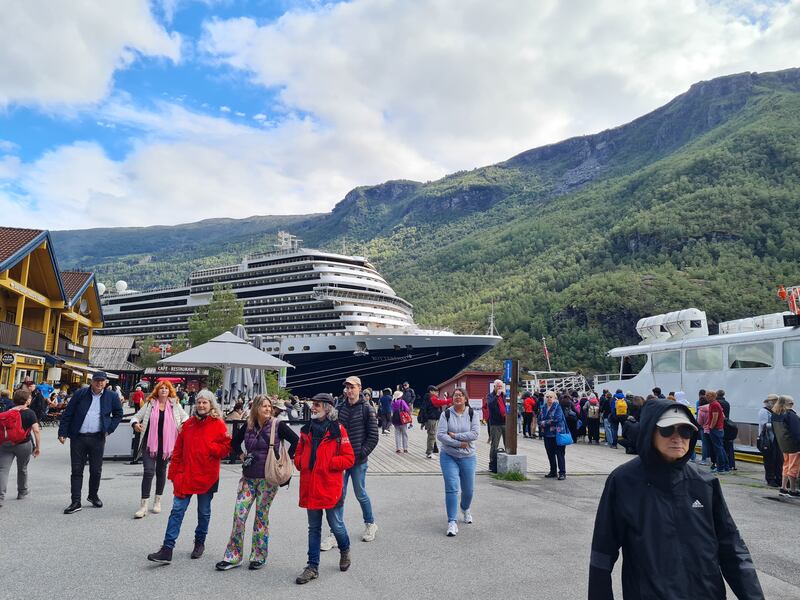Landing in Bergen, there’s a lot to make a Corkman feel at home. A walkable port city built on a series of hills with a noble history but also an unavoidable sense that it is the country’s second city. Sunniva, the patron saint of the former capital, was the daughter of an Irish king who found refuge on the Norwegian coast after fleeing Viking invaders. I’m making the same journey, albeit in more leisurely circumstances, with thousands of other visitors to the “gateway to the fjords”.
An early train takes you right into Sognefjord, the largest of Norway’s fjords, stretching for 200km. Shortly after leaving Bergen it becomes clear why this is deemed one of the most picturesque train routes in the world. Lakes, green fields and mountains line the route to Myrdal station, a remote outpost where urban civilisation feels a long way away. Flam is the next stop.
The Flamsbana train is an incredible feat of engineering. Built between 1923 and 1940 it is one of the world’s steepest railway lines. The 20km long railway has 20 tunnels in total, all bar two of them excavated by hand. The number working on the line fluctuated between as low as 80 and an all-time high of 280 people in 1937. An exhibit on the train claims it would take a navvy a month to dig a metre of the tunnel, with almost 5,700m to dig in total. Hand-construction was done by drilling through the rock, filling the holes with dynamite and blasting. The construction costs topped out at about 20 million krone, according to the museum in the village.
The line opened on August 1st, 1940, with two steam trains in each direction that connected with the day trains on the Bergen railway line. The views from the quaint green carriages down into the valleys are astonishing.
Norway remains the world’s fifth largest oil exporter and third largest natural gas exporter, while surplus profits in the 1990s laid the foundation for the development of the world’s biggest sovereign wealth fund
Flam itself is a tiny village which is home to about 400 people but welcomes hundreds of thousands of tourists each year. In fact, the railway initially built as a link between Bergen and Oslo is now almost solely a tourist attraction. The village is a short stop on the almost crassly marketed and overly expensive Norway in a Nutshell route, encouraging the idea that tourists can cross the fjords off their lists with a brief stop to have a slice of reindeer salami with a glass of mead, massive suitcases in tow.


Scandinavia received a tourism surge this year as people sought alternatives to the scorching heat of the Mediterranean and look to take advantage of the unusually weak krone. In a year in which Venice introduced a €5 entry fee for tourists and thousands of locals took to the streets in protests across Spain, this influx has caused a few problems for Norway.
Its culture prizes the “right to roam” and the Allemannsretten laws, which give Norwegians the legal right to camp, swim, ski and walk freely in nature, regardless of who the landowner is. In the summer a tourism campaign aimed at promoting this to tourists seeking outdoor activities was suspended after warnings mass tourism could lead to environmental destruction. The hulking cruise ships eating into the stunning landscape in the harbour of Flam don’t do anything to dispel those concerns.
In 2018, the government moved to ban cruise ships from the fjords, allowing only zero-emission vessels in from 2026. However, in August, the ban was postponed until 2032. The requirements will now be implemented gradually, as parliament “accepts the technology for larger ships is not yet sufficiently advanced”. In Bergen itself, the council allows only 8,000 cruise ship passengers ashore each day.
Norway has some of the strongest climate action ambitions in Europe, with a stated goal of being “carbon neutral” by 2030 and reducing emissions by 55 per cent compared with 1990 levels by 2050. It is already making major strides in renewable energy with more than 90 per cent of its electricity provided by hydropower. It bucks the European trend on EVs with electric cars now outnumbering petrol cars for the first time, accounting for 94 per cent of new registrations in August.
However, Norway remains the world’s fifth largest oil exporter and third largest natural gas exporter, while surplus profits in the 1990s laid the foundation for the development of the world’s biggest sovereign wealth fund. Amid industry fears that output will decline from next year, oil companies plan to drill more than 40 exploration wells off the coast.
These glaring contradictions push the country into uneasy compromises such as the two recent U-turns on tourism policy with even more important decisions ahead. It’s yet more evidence of what columnist Shazia Majid described as: “Norway and Norwegians struggle with the dilemma of retaining their privileges, which flow largely from fossil fuels, while scrambling to save nature.”
- Sign up for push alerts and have the best news, analysis and comment delivered directly to your phone
- Find The Irish Times on WhatsApp and stay up to date
- Our In The News podcast is now published daily – Find the latest episode here






















